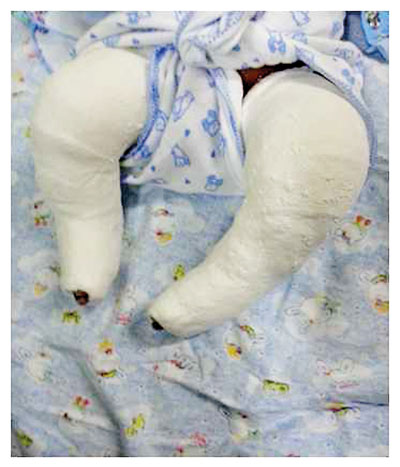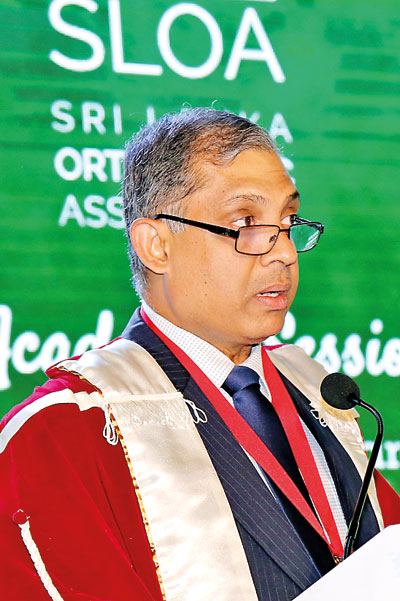From clubfoot to normal feet

Before 1st cast
What joy and hope when a baby is born to a couple. Sometimes, though, there comes heartache, for the newborn has one or even both feet that may be deformed or badly-shaped.
The reality hits then……it is clubfoot.

The 1st cast
From clubfoot to normal feet, MediScene asks Consultant Orthopaedic Surgeon Dr. Sunil Wijayasinghe attached to the Lady Ridgeway Hospital (LRH) for Children in Colombo what the process is and how Sri Lanka helps such children.
The LRH which serves as the National Referral Centre for Paediatric Care in the country, has a ‘Clubfoot Clinic’ every Tuesday.
Explaining that clubfoot is the “commonest” foot deformity seen at birth, Dr. Wijayasinghe says that the tissues connecting the muscles to the bone (tendons) on the inside of the leg are shorter than usual. The bones have an unusual shape and there is a rotation of the feet inwards at the ankles, with the soles facing each other. The Achilles tendon is tightened.
This condition, MediScene learns, is grouped into three types:
Idiopathic clubfoot – known as talipes equinovarus (TEV), this is the commonest type and is evident at birth. There is no known cause for idiopathic clubfoot which usually involves one foot. Of children treated at the LRH clinic, about 95% had idiopathic clubfoot.
Syndromic clubfoot – this is linked to other clinical conditions of underlying syndromes. These syndromes include Arthrogryposis; Constriction Bands; Moebius Syndrome; Freeman Sheldon Syndrome; Diastrophic Dwarfism; Tibial Hemimelia; Spitz Syndrome; and Pierre Robin Syndrome. Syndromic clubfoot accounted for about 5% treated at the LRH clinic.

After 3 years
Neurogenic clubfoot – this is caused by an underlying neurologic condition such as spina bifida and myelomeningocele. It may also develop later in childhood due to cerebral palsy or a spinal cord compression.
Pointing out that there seems to be a genetic pre-disposition and extensive research is being conducted to find the causative gene, Dr. Wijayasinghe says the incidence of clubfoot the world over is 1 per 1,000 live births.
With Sri Lanka having around 400,000 live births per year, the country would have about 400 babies born with cluboot per year, he says, adding that 80% of babies born with clubfoot are in the developing world. Usually more baby boys are born with this deformity than baby girls, with the ratio being 3:1. Some are born with the deformity in one foot (unilateral – about 40%) and others in both feet (bilateral – about 60%).
The good news is that if properly treated, the clubfoot deformity is “fully correctable”, reiterates Dr. Wijayasinghe, showing photographs – before and after the 1st cast; before and after the 2nd cast; before and after the 3rd cast; before and after the 4th cast; before and after the fifth cast – of just one child of many whose condition has been put right at the LRH. Finally, the little one’s normal feet are seen at age three.
The ‘Ponseti method’ has become the gold standard of care for the treatment of congenital clubfoot, MediScene learns. This technique for the correction of paediatric clubfoot was introduced to the world by Spanish Orthopaedic Surgeon Dr. Ignacio V. Ponseti.

Dr. Sunil Wijayasinghe
| What is the Ponseti technique? The Ponseti technique is the conservative and gentle manipulation of the baby’s foot by the doctor with the aim of correcting the bend and then the weekly serial plaster casting from the toes to the thigh, to hold the foot in position, says Dr. Sunil Wijayasinghe. Dr. Wijayasinghe explains that the correction also entails minor surgery, in the form of an Achilles tenotomy to release the Achilles tendon and the use of specific orthotic devices (foot-abduction braces). He takes us through the step-by-step procedure at the LRH’s ClubFoot Clinic – registration of all new patients, after which an Orthopaedic Surgeon assesses the child and performs manipulation. While a very clear instruction sheet is given to the parents of the child, the plaster casting and manufacture of the braces are all carried out in-house by LRH staff, it is understood. He pays tribute to his team including doctors, nurses, support staff and prosthetic & orthotic workshop staff for the good work done. It was Dr. Ponseti who had said in 1996 that parents of infants born with clubfeet may be reassured that their baby, if otherwise normal, when treated by expert hands will have normal looking feet with normal function for all practical purposes. The well-treated clubfoot is no handicap and is fully compatible with normal, active life. This is what the LRH staff is engaged in week after week– helping children to overcome this deformity and get on with life. All data gathered at the LRH clinic are submitted to the International Clubfoot Registry (ICR), enabling analysis as well as the sharing of findings with other countries. | |


